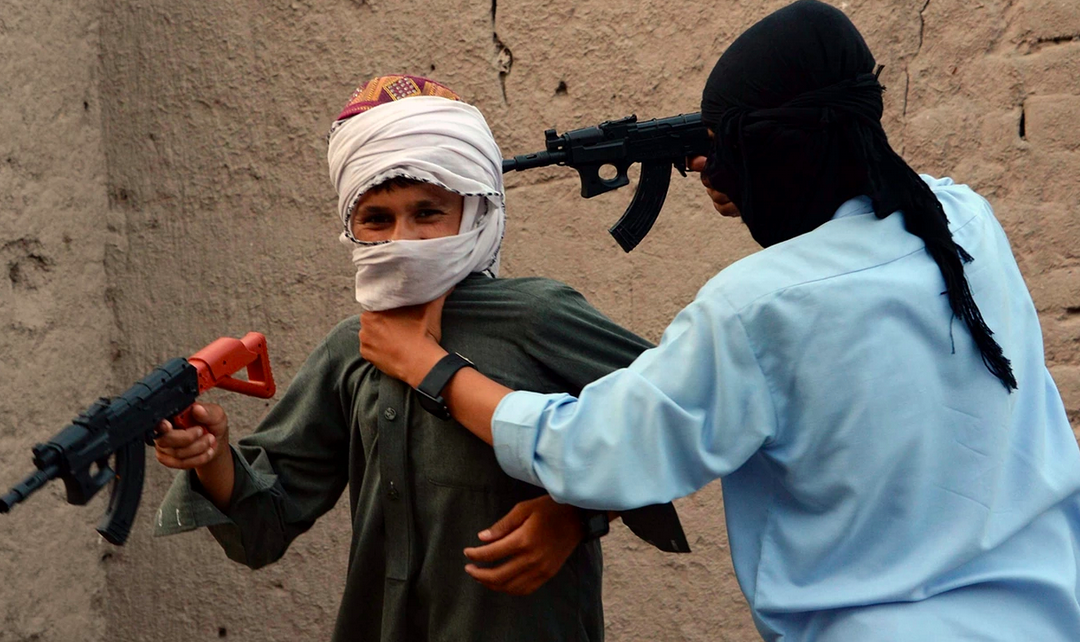Afghan Strategy To Curb Violence: Ban Toy Guns
Toy guns banned in Afghanistan

NEW DELHI: Afghanistan is a troubled country. Since 2009 -- when the United Nations Assistance Mission in Afghanistan began tracking casualties -- the armed conflict in Afghanistan has caused 47,745 civilian casualties with 17,774 Afghan civilians killed and 29,971 injured. These numbers are in all probability an under representation, as a majority of civilian deaths go unrecorded. A culture of violence, therefore, is very much part of Afghan life. The Afghan government’s move to ban the sale of imitation Kalashnikovs and other fake guns after the toys caused injuries to more than 100 people during Eid al-Fitr celebrations -- is located in a wider effort to curb the culture of violence in the war-torn country.
(Young Afghan boys with toy guns. @HJalalzai )
(Young Afghan boys play a game with toy guns. @moscow_ghost).
“Interior minister Noor-ul Haq Uloomi has ordered police to confiscate all toy guns which can lead to physical and psychological damage,” a ministry statement said. The decision seems to be in line with the logic that guns -- toy or real -- can influence impressionable young minds.
Toy guns are part of almost all societies, but in Afghanistan they take on a slightly different context given the country’s context of militancy. Young boys tottering around with toy guns and rubber pellets are a common sight on Afghanistan’s streets, and more so during the festival of Eid, when Eidi is used to buy such toys. This Eid, more than 100 children and teenagers suffered eye injuries as they brandished their new toys.
Judging by social media commentators, some thought the move was positive.
Others, however, pointed out that this move may have little impact on the larger culture of violence in Afghanistan.
That larger culture of violence is evinced by the fact that the casualties seem to be rising. The United Nations has estimated that 1000 civilians have died in the country in the first four months of 2015. Another 2000 civilians have been injured. The numbers represent a 50 percent increase from the same period last year, worrying as 2014 has been the most deadly year in Afghanistan yet.
If the trend continues, then 2015 is poised to be worse than 2014 in terms of civilian casualties. According to a recent UN report, the number of civilians killed or wounded in the troubled country climbed by 22 percent in 2014 to reach the highest level since 2009.
The UN agency documented 10,548 civilian casualties in 2014, the highest number of civilian deaths and injuries recorded in a single year since 2009. They include 3,699 civilian deaths, up 25 per cent from 2013 and 6,849 civilian injuries, up 21 per cent from 2013. Since 2009 -- when UNAMA began tracking casualties -- the armed conflict in Afghanistan has caused 47,745 civilian casualties with 17,774 Afghan civilians killed and 29,971 injured.
(Young Afghan boys with toy guns @halshoaziz).
(“Afghan kids playing with toy guns in streets. What else they cud emulate after growing up in a war zone#Afghanistan” @koolkopper)
The UN says that Taliban militants -- who have been waging an insurgency in Afghanistan since a US-led invasion toppled their government 13 years ago -- were responsible for 72 per cent of all civilian casualties, with government forces and foreign troops responsible for 14 percent.
For the first time since 2009, more Afghan civilians were killed and injured in ground engagements than by improvised explosive devices (IEDs) or any other tactic. The report found that civilian deaths and injuries from ground operations surged by 54 per cent making them the leading cause of civilian casualties and the biggest killers of Afghan women and children in 2014.
The UN also noted that women and children were particularly hard hit by the armed conflict and increased ground engagements in 2014. UNAMA documented a 40 per cent increase in children casualties with 2,474 children casualties (714 killed and 1,760 injured) compared to 2013. Women casualties increased by 21 per cent with 298 women killed and 611 injured.
Are toy guns part of the answer? The question remains.



